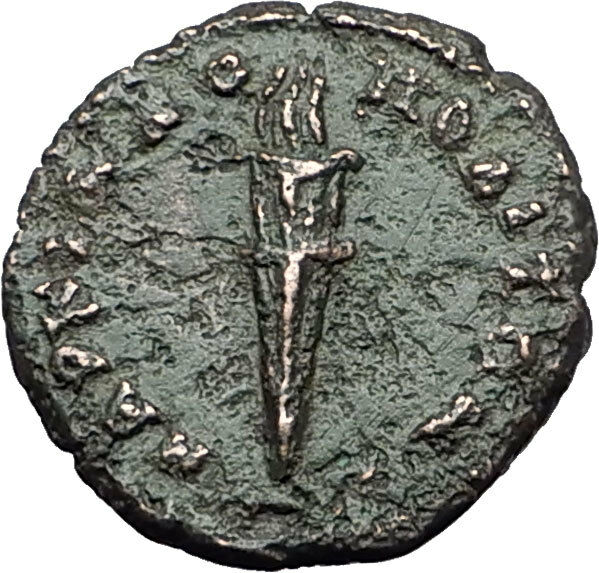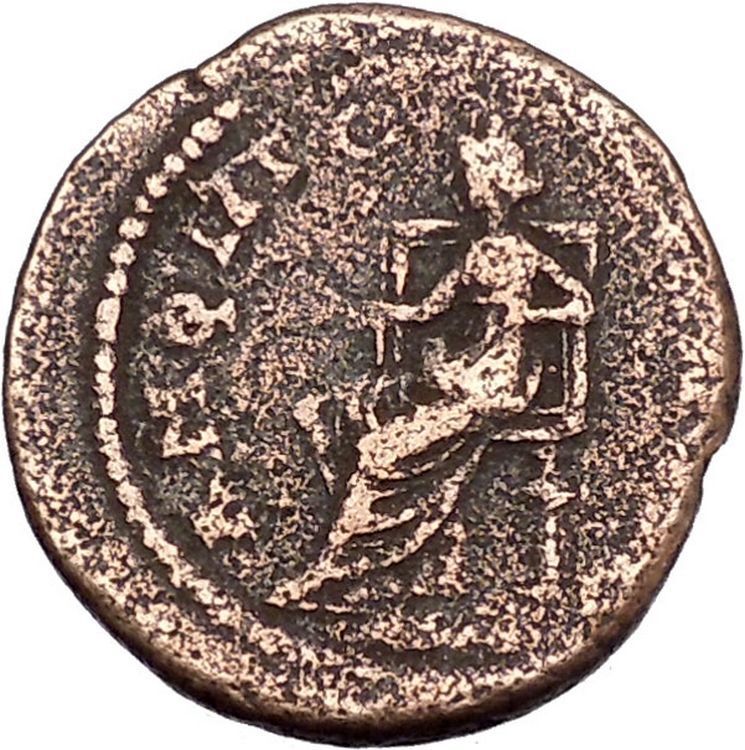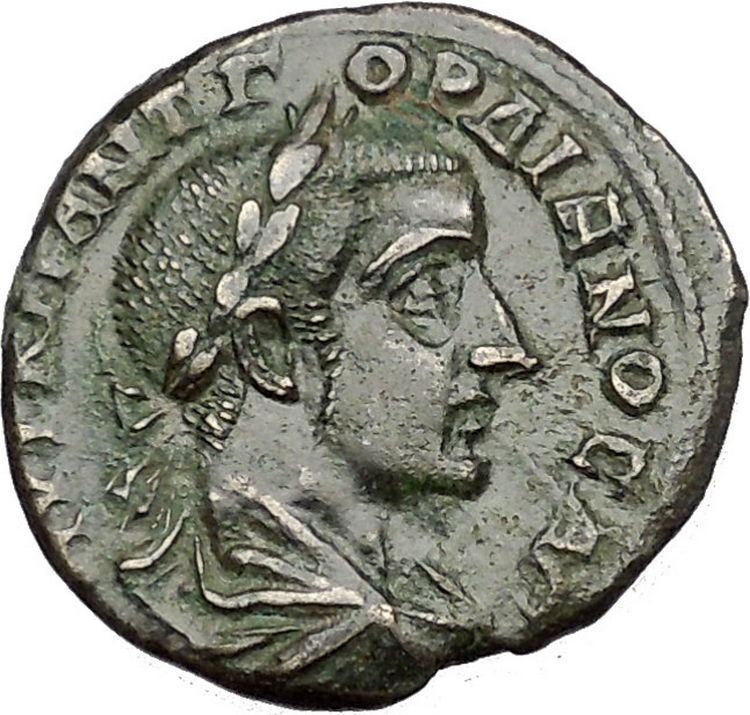Item: i45222

Authentic Ancient Roman Coin of:
Gordian III – Roman Emperor: 238-244 A.D. –
Bronze 25mm (9.11 grams) of Hadrianopolis in Thrace
Reference: Moushmov 2734
AVT K M ANT ΓOPΔIANOC, laureate, draped & cuirassed bust right.
AΔPIANOΠOΛЄITΩN, Serapis standing left, holding long staff & raising right arm.
You are bidding on the exact item pictured, provided with a Certificate of Authenticity and Lifetime Guarantee of Authenticity.
Serapis is a Graeco-Egyptian god. Serapis was devised during the 3rd century BC on the orders of Ptolemy I of Egypt as a means to unify the Greeks and Egyptians in his realm. The god was depicted as Greek in appearance, but with Egyptian trappings, and combined iconography from a great many cults, signifying both abundance and resurrection. A serapeum (Greek serapeion) was any temple or religious precinct devoted to Serapis. The cultus of Serapis was spread as a matter of deliberate policy by the Ptolemaic kings , who also built an immense Serapeum in Alexandria.

Serapis continued to increase in popularity during the Roman period , often replacing Osiris as the consort of Isis in temples outside Egypt. In 389, a mob led by the Patriarch Theophilus of Alexandria destroyed the Alexandrian Serapeum, but the cult survived until all forms of religion other than Nicene Christianity were suppressed or abolished under Theodosius I in 391.
About the god
“Serapis” is the only form used in Latin, but both Ancient Greek : Σάραπις Sárapis and Ancient Greek : Σέραπις Sérapis appear in Greek, as well as Ancient Greek : Σαραπo Serapo in Bactrian.
His most renowned temple was the Serapeum of Alexandria . Under Ptolemy Soter , efforts were made to integrate Egyptian religion with that of their Hellenic rulers. Ptolemy’s policy was to find a deity that should win the reverence alike of both groups, despite the curses of the Egyptian priests against the gods of the previous foreign rulers (e.g. Set , who was lauded by the Hyksos ). Alexander the Great had attempted to use Amun for this purpose, but he was more prominent in Upper Egypt , and not as popular with those in Lower Egypt , where the Greeks had stronger influence. The Greeks had little respect for animal-headed figures, and so a Greek-style anthropomorphic statue was chosen as the idol , and proclaimed as the equivalent of the highly popular Apis . It was named Aser-hapi (i.e. Osiris-Apis), which became Serapis, and was said to be Osiris in full, rather than just his Ka (life force).
History
The earliest mention of a Serapis is in the disputed death scene of Alexander (323 BC). Here, Serapis has a temple at Babylon , and is of such importance that he alone is named as being consulted on behalf of the dying king. His presence in Babylon would radically alter perceptions of the mythologies of this era: the unconnected Babylonian god Ea (Enki) was titled Serapsi, meaning ‘king of the deep’, and it is possible this Serapis is the one referred to in the diaries. The significance of this Serapsi in the Hellenic psyche, due to its involvement in Alexander’s death, may have also contributed to the choice of Osiris-Apis as the chief Ptolemaic god.
According to Plutarch , Ptolemy stole the cult statue from Sinope , having been instructed in a dream by the “unknown god” to bring the statue to Alexandria , where the statue was pronounced to be Serapis by two religious experts. One of the experts was of the Eumolpidae , the ancient family from whose members the hierophant of the Eleusinian Mysteries had been chosen since before history, and the other was the scholarly Egyptian priest Manetho , which gave weight to the judgement both for the Egyptians and the Greeks.
Plutarch may not be correct, however, as some Egyptologists allege that the Sinope in the tale is really the hill of Sinopeion, a name given to the site of the already existing Serapeum at Memphis . Also, according to Tacitus , Serapis (i.e., Apis explicitly identified as Osiris in full) had been the god of the village of Rhakotis before it expanded into the great capital of Alexandria.
 High Clerk in the Cult of Serapis, Altes Museum , Berlin
High Clerk in the Cult of Serapis, Altes Museum , Berlin
The statue suitably depicted a figure resembling Hades or Pluto , both being kings of the Greek underworld , and was shown enthroned with the modius , a basket/grain-measure, on his head, since it was a Greek symbol for the land of the dead. He also held a sceptre in his hand indicating his rulership, with Cerberus , gatekeeper of the underworld, resting at his feet, and it also had what appeared to be a serpent at its base, fitting the Egyptian symbol of rulership, the uraeus .
With his (i.e. Osiris’s) wife Isis, and their son Horus (in the form of Harpocrates ), Serapis won an important place in the Greek world . In his Description of Greece, Pausanias notes two Serapeia on the slopes of Acrocorinth , above the rebuilt Roman city of Corinth and one at Copae in Boeotia.
Serapis was among the international deities whose cult was received and disseminated throughout the Roman Empire, with Anubis sometimes identified with Cerberus. At Rome, Serapis was worshiped in the Iseum Campense, the sanctuary of Isis built during the Second Triumvirate in the Campus Martius . The Roman cults of Isis and Serapis gained in popularity late in the 1st century when Vespasian experienced events he attributed to their miraculous agency while he was in Alexandria, where he stayed before returning to Rome as emperor in 70. From the Flavian Dynasty on, Serapis was one of the deities who might appear on imperial coinage with the reigning emperor.
The main cult at Alexandria survived until the late 4th century, when a Christian mob destroyed the Serapeum of Alexandria in 385, and the cult was part of the general proscription of religions other than approved forms of Christianity under the Theodosian decree .
Gallery
Oil lamp with a bust of Serapis, flanked by a crescent moon and star (Roman-era Ephesus , 100-150)
 Statuette possibly of Serapis (but note the herculean club) from Begram , Afghanistan
Statuette possibly of Serapis (but note the herculean club) from Begram , Afghanistan  Head of Serapis, from a 12-foot statue found off the coast of Alexandria
Head of Serapis, from a 12-foot statue found off the coast of Alexandria  Head of Serapis (Roman-era Hellenistic terracotta, Staatliches Museum Ägyptischer Kunst, Munich)
Head of Serapis (Roman-era Hellenistic terracotta, Staatliches Museum Ägyptischer Kunst, Munich)
Edirne (ancient Hadrianopolis) is a city in Thrace , the westernmost part of Turkey , close to the borders with Greece and Bulgaria . Edirne served as the capital city of the Ottoman Empire from 1365 to 1457, when Constantinople (Istanbul) became the empire’s new capital. At present, Edirne is the capital of the Edirne Province in Turkish Thrace . The city’s estimated population in 2002 was 128,400, up from 119,298 in 2000. It has consulates of Bulgaria, Germany (Honorary), Greece, Romania (Honorary) and Slovakia (Honorary). Its sister cities are Haskovo and Yambol in Bulgaria and Alexandroupoli in Greece .
The city was founded as Hadrianopolis , named for the Roman Emperor Hadrian . This name is still used in the Modern Greek (Αδριανούπολη). The English name Adrianople, by which the city was known until the Turkish Postal Service Law of 1930, has fallen into disuse. The Turkish Edirne, the Bulgarian Одрин (Odrin), and the Serbian Једрене (Jedrene) are adapted forms of the name Hadrianopolis.
Marcus Antonius Gordianus Pius (January 20, 225 – February 11 , 244 ), known in English as Gordian III,  was Roman Emperor from 238 to 244. Gordian was the son of Antonia Gordiana and his father was an unnamed Roman Senator who died before 238. Antonia Gordiana was the daughter of Emperor Gordian I and younger sister of Emperor Gordian II . Very little is known on his early life before becoming Roman Emperor. Gordian had assumed the name of his maternal grandfather in 238.
was Roman Emperor from 238 to 244. Gordian was the son of Antonia Gordiana and his father was an unnamed Roman Senator who died before 238. Antonia Gordiana was the daughter of Emperor Gordian I and younger sister of Emperor Gordian II . Very little is known on his early life before becoming Roman Emperor. Gordian had assumed the name of his maternal grandfather in 238.
Following the murder of emperor Alexander Severus in Moguntiacum (modern Mainz ), the capital of the Roman province Germania Inferior , Maximinus Thrax was acclaimed emperor, despite strong opposition of the Roman senate and the majority of the population. In response to what was considered in Rome as a rebellion, Gordian’s grandfather and uncle, Gordian I and II, were proclaimed joint emperors in the Africa Province . Their revolt was suppressed within a month by Cappellianus, governor of Numidia and a loyal supporter of Maximinus Thrax. The elder Gordians died, but public opinion cherished their memory as peace loving and literate men, victims of Maximinus’ oppression.
Meanwhile, Maximinus was on the verge of marching on Rome and the Senate elected Pupienus and Balbinus as joint emperors. These senators were not popular men and the population of Rome was still shocked by the elder Gordian’s fate, so that the Senate decided to take the teenager Gordian, rename him Marcus Antonius Gordianus as his grandfather, and raise him to the rank of Caesar and imperial heir. Pupienus and Balbinus defeated Maximinus, mainly due to the defection of several legions , namely the Parthica II who assassinated Maximinus. But their joint reign was doomed from the start with popular riots, military discontent and even an enormous fire that consumed Rome in June 238. On July 29 , Pupienus and Balbinus were killed by the Praetorian guard and Gordian proclaimed sole emperor.
Rule
Due to Gordian’s age, the imperial government was surrendered to the aristocratic families, who controlled the affairs of Rome through the senate. In 240, Sabinianus revolted in the African province, but the situation was dealt quickly. In 241, Gordian was married to Furia Sabinia Tranquillina , daughter of the newly appointed praetorian prefect, Timesitheus . As chief of the Praetorian guard and father in law of the emperor, Timesitheus quickly became the de facto ruler of the Roman empire.
In the 3rd century, the Roman frontiers weakened against the Germanic tribes across the Rhine and Danube , and the Sassanid kingdom across the Euphrates increased its own attacks. When the Persians under Shapur I invaded Mesopotamia , the young emperor opened the doors of the Temple of Janus for the last time in Roman history, and sent a huge army to the East. The Sassanids were driven back over the Euphrates and defeated in the Battle of Resaena (243). The campaign was a success and Gordian, who had joined the army, was planning an invasion of the enemy’s territory, when his father-in-law died in unclear circumstances. Without Timesitheus, the campaign, and the emperor’s security, were at risk.
Marcus Julius Philippus, also known as Philip the Arab , stepped in at this moment as the new Praetorian Prefect and the campaign proceeded. In the beginning of 244, the Persians counter-attacked. Persian sources claim that a battle was fought (Battle of Misiche) near modern Fallujah (Iraq) and resulted in a major Roman defeat and the death of Gordian III[1]. Roman sources do not mention this battle and suggest that Gordian died far away, upstream of the Euphrates. Although ancient sources often described Philip, who succeeded Gordian as emperor, as having murdered Gordian at Zaitha (Qalat es Salihiyah), the cause of Gordian’s death is unknown.
Gordian’s youth and good nature, along with the deaths of his grandfather and uncle and his own tragic fate at the hands of another usurper, granted him the everlasting esteem of the Romans. Despite the opposition of the new emperor, Gordian was deified by the Senate after his death, in order to appease the population and avoid riots.
Your browser does not support JavaScript. To view this page, enable JavaScript if it is disabled or upgrade your browser.
Frequently Asked Questions
How long until my order is shipped?
Depending on the volume of sales, it may take up to 5 business days for shipment of your order after the receipt of payment.
How will I know when the order was shipped?
After your order has shipped, you will be left positive feedback, and that date should be used as a basis of estimating an arrival date.
After you shipped the order, how long will the mail take?
USPS First Class mail takes about 3-5 business days to arrive in the U.S., international shipping times cannot be estimated as they vary from country to country. I am not responsible for any USPS delivery delays, especially for an international package.
What is a certificate of authenticity and what guarantees do you give that the item is authentic?
Each of the items sold here, is provided with a Certificate of Authenticity, and a Lifetime Guarantee of Authenticity, issued by a world-renowned numismatic and antique expert that has identified over 10000 ancient coins and has provided them with the same guarantee. You will be quite happy with what you get with the COA; a professional presentation of the coin, with all of the relevant information and a picture of the coin you saw in the listing.
Compared to other certification companies, the certificate of authenticity is a $25-50 value. So buy a coin today and own a piece of history, guaranteed.
Is there a money back guarantee?
I offer a 30 day unconditional money back guarantee. I stand behind my coins and would be willing to exchange your order for either store credit towards other coins, or refund, minus shipping expenses, within 30 days from the receipt of your order. My goal is to have the returning customers for a lifetime, and I am so sure in my coins, their authenticity, numismatic value and beauty, I can offer such a guarantee.
Is there a number I can call you with questions about my order?
You can contact me directly via ask seller a question and request my telephone number, or go to my About Me Page to get my contact information only in regards to items purchased on eBay.
When should I leave feedback?
Once you receive your order, please leave a positive. Please don’t leave any negative feedbacks, as it happens many times that people rush to leave feedback before letting sufficient time for the order to arrive. Also, if you sent an email, make sure to check for my reply in your messages before claiming that you didn’t receive a response. The matter of fact is that any issues can be resolved, as reputation is most important to me. My goal is to provide superior products and quality of service.
Your browser does not support JavaScript. To view this page, enable JavaScript if it is disabled or upgrade your browser.






